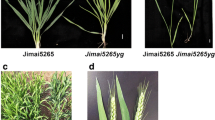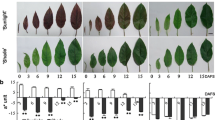Abstract
A novel yellow-leaved cultivar of tropical tree was characterized with morphological, histochemical and biochemical analysis.Ficus microcarpa L. f. cv. Golden Leaf shows characteristic golden (yellow) leaves as well as normal green leaves under the subtropical field condition. Except the appearance of the yellow leaves, morphological characteristics of Golden Leaf agreed to those of wild-type. The yellow leaves of Golden Leaf contained low amount of chlorophyll (8%) and carotenoid (26%), whereas flavonoid level was 5-fold higher than that of wild-type. TLC of hydrolysate of the methanol-extract showed the increase of two flavonols in the yellow leaves. Fluorescence from leaf transverse section indicated that those changes in pigment contents took place in mesophyll cells. Despite low content of photosynthetic pigments the yellow leaves involved the comparable amount of Rubisco subunits to wild-type. The reduced chlorophyll content of the yellow leaves was restored by shading them from high-light but the UV-shading did not alter the pigment content. Those characteristics of the yellow leaves were not observed in the green leaves of Golden Leaf. Results suggest that Golden Leaf is attributed to a chloroplast mutant ofF. microcarpa that is sensitive to continuous high-light irradiation. The mechanism of the leaf-goldenning (yellowing) is discussed in relation to high-light stress and to leaf-senescence.
Similar content being viewed by others
Abbreviations
- PS II:
-
oxygen-evolving photosystem of thylakoid membranes
- Rubisco:
-
ribulose-1, 5-bisphosphate carboxylase
- TLC:
-
thin layer chromatography
References
Bors, W., Heller, W., Michel, C. andSaran M. 1990. Flavonoids as antioxidants: determination of radicalscavenging efficiencies. Methods Enzymol.186: 343–355.
Charrloto-Ladreix, Y. andTissut, M. 1981. Foliar flavonoid distribution duringSpinacia chloroplast isolation. Planta151: 309–313.
Chua, N.-H. 1980. Electrophoretic analysis of chloroplast proteins. Methods Enzymol.69: 434–446.
Davies, B.H. 1976. CarotenoidsIn T.W. Goodwin, ed., Chemistry and Biochemistry of Plant Pigments, vol. 2, Academic Press, London, pp. 38–165.
Eckardt, N.A. andPell, E.J. 1994. O3-induced degradation of Rubisco protein and loss of Rubisco mRNA in relation to leaf age inSolanum tuberosum L. New Phytol.127: 741–748.
Edwards, G.E., Johnson, E., Lal, A. andKrall, J.P. 1993. Quantum yields of photosystem II and photosynthesis in an aurea mutant of tobacco (C3) and an oil yellow mutant of maize (C4) which have high capacities for photosynthesis despite low chlorophyll contents. Plant Cell Physiol.34: 1205–1212.
Ginsburg, S., Schellenberg, M. andMatile, P. 1994. Cleavage of chlorophyll-porphyrin. Plant Physiol.105: 545–554.
Goud, K.V. andSharma, R. 1994. Retention of photoinduction of cytosolic enzymes inaurea mutant of tomato (Lycopersicon esculentum). Plant Physiol.105: 643–650.
Harborne, J.B. 1959. The chromatography of the flavonoid pigments. J. Chromatog.2: 581–604.
Harborne, J.B. 1989. General procedures and measurement of total phenoiics.In J.B. Harborne, ed., Methods in Plant Biochemistry, vol. 1, Academic Press, London, pp. 1–28.
Hidema, J., Makino, A., Mae, T. andOjima, K. 1991. Photosynthetic characteristics of rice leaves aged under different irradiances from full expansion through senescence. Plant Physiol.97: 1287–1293.
Hogan, K.P., Smith, A.P. andZiska, L.H. 1991. Potential effects of elevated CO2 and changes in temperature on tropical plants. Plant Cell Environ.14: 763–778.
Kamaluddin, M. andGrace, J. 1992. Photoinhibition and light acclimation in seedlings ofBishofia javanica, a tropical forest tree from Asia. Ann. Bot.69: 47–52.
Kar, M., Streb, P., Hertwig, B. andFeierabend, J. 1993. Sensitivity to photodamage increases during senescence in excised leaves. J. Plant. Physiol.141: 538–544.
Kaufmann, S., McKey, D.B., Hossaert-McKey, M. andHorvitz, C.C. 1991. Adaptations for a two-phase seed dispersal system involving vertebrates and ants in a hemiepiphytic fig (Ficus microcarpa: Moraceae). Amer. J. Bot.78: 971–977.
Kyle, D.J. 1987. The biochemical basis for photoinhibition of photosystem II.In D.J. Kyle, C.B. Osmond and C.J. Arntzen, eds., Topics in Photosynthesis, vol. 9, Elsevier, Amsterdam, pp. 197–226.
Li, J., Ou-Lee, T.-M., Raba, R., Amundson, R.G. andLast, R.L. 1993. Arabidopsis flavonoid mutants are hypersensitive to UV-B irradiation. Plant Cell5: 171–179.
Long, S.P., Humphries, S. andFalkowski, P.G. 1994. Photoinhibition of photosynthesis in nature. Ann. Rev. Plant Physiol. Plant Mol. Biol.45: 633–662.
Lovelock, C.E. andClough, B.F. 1992. Influence of solar radiation and leaf angle on leaf xanthophyll concentrations in mangroves. Oecologia91: 518–525.
Lovelock, C.E., Jebb, M. andOsmond, C.B. 1994. Photoinhibition and recovery in tropical plant species: response to disturbance. Oecologia97: 297–307.
Matile, P., Ginsburg, S., Schellenberg, M. andThomas, H. 1988. Catabolites of chlorophyll in senescing barely leaves are localized in the vacuoles of mesophyll cells. Proc. Natl. Acad. Sci. USA85: 9529–9532.
Middleton, E.M. andTeramura, A.H. 1993. The role of flavonol glycosides and carotenoids in protecting soybean from ultraviolet-B damage. Plant Physiol.103: 741–752.
Moreno, M.R., Smith, J.F. andSmith, R.V. 1985. Silver staining of proteins in polyacrylamide gels: increased sensitivity through a combined coomassie blue-silver stain procedure. Anal. Biochem.151: 466–470.
Mulkey, S.S. andPearcy, R.W. 1992. Interactions between acclimation and photoinhibition of photosynthesis of a tropical forest understorey herb,Alocasia macrorrhiza, during simulated canopy gap formation. Funct. Ecol.6: 719–729.
Pell, E.J., Eckardt, N.A. andGlick, R.E. 1994. Biochemical and molecular basis for impairment of photosynthetic potential. Photosynth. Res.39: 453–462.
Poethig, R.S. 1987. Clonal analysis of cell lineage patterns in plant development. Amer. J. Bot.74: 581–594.
Randel, W.J., Gille, J.C., Roche, A.E., Kumer, J.B., Mergenthaler, J.L., Waters, J.W., Fishbein, E.F. andLahoz, W.A. 1993. Stratospheric transport from the tropics to middle latitudes by planetary-wave mixing. Nature365: 533–535.
Schmelzer, E., Jahnen, W. andHahlbrock, K. 1988.In situ localization of light-induced chalcone synthase mRNA, chalcone synthase, and flavoncid end products in epidermal cells of parsley leaves. Proc. Natl. Acad. Sci. USA85: 2989–2999.
Schnabl, H., Weissenböck, G. andScharf, H. 1986.In vivo-microspectrophotometric characterization of flavonol glycosides inVicia faba guard and epidermal cells. J. Exp. Bot.37: 61–72.
Schöner, S. andKrause, G.H. 1990. Protective systems against active oxygen species in spinach: response to cold acclimation in excess light. Planta180: 383–389.
Takahama, U. 1984. Hydrogen peroxide-dependent oxidation of flavonols by intact spinach chloroplasts. Plant Physiol.74: 852–855.
Takahama, U. 1988. Hydrogen peroxide-dependent oxidation of flavonoids and hydroxycinnamic acid derivatives in epidermal and guard cells ofTradescantia virginiana L. Plant Cell Physiol.29: 475–481.
Takahama, U. 1989. A role of hydrogen peroxide in the metabolism of phenolics in mesophyll cells ofVicia faba L. Plant Cell Physiol.30: 295–301.
Takahama, U., Egashira, T. andWakamatsu, K. 1989. Hydrogen peroxide-dependent synthesis of flavonols in mesophyll cells ofVicia faba L. Plant Cell Physiol.30: 951–955.
The Japan Meteorological Agency 1991. Figures of global ozone distributions (1978–1989).In Technical Data Series, No. 56, The Japan Meteorological Agency, Tokyo (in Japanese).
Thompson, J.E., Legge, R.L. andBarber, R.F. 1987. The role of free radicals in senescence and wounding. New Phytol.105: 317–344.
Walker, E.H. 1976. Flora of Okinawa and the Southern Ryukyu Islands, Smithsonian Institution Press, Washington, D.C.
Author information
Authors and Affiliations
Rights and permissions
About this article
Cite this article
Yamasaki, H., Heshiki, R. & Ikehara, N. Leaf-goldenning induced by high light inFicus microcarpa L. f., a tropical fig. J. Plant Res. 108, 171–180 (1995). https://doi.org/10.1007/BF02344341
Received:
Accepted:
Issue Date:
DOI: https://doi.org/10.1007/BF02344341




